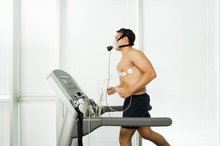How to Calculate EER
Working out at the gym, digesting food and even sleeping are activities that require energy in the form of calories. The amount of calories you need to maintain your current weight is known as your estimated energy requirement, or EER. The EER is based on several variables, including age, gender, height, weight and activity level. While the EER is usually pretty accurate, it does have its limitations. Since it doesn't take into account muscle mass or percentage of body fat, your needs may be higher or lower than the EER estimate.
Metric Math
For the EER calculation, you'll need to know your height and weight in metric units. To make the conversion, divide your height in inches by 39.37 to find your height in meters. For instance, a woman who is 65 inches tall would divide 65 by 39.37 to determine her height in meters, 1.65. To convert your weight from pounds to kilograms, divide by 2.2. If the same woman weighed 140 pounds, her weight would be 140 divided by 2.2, or 63.63 kilograms.
Gender Differences
What Makes People Grow Taller?
Learn More
The formula for EER is different for men and women. For men 19 and older, EER equals [662 – (9.53 x age)] + PA x [(15.91 x weight) + (539.6 x height)]. For women 19 and older, EER equals [(354 – (6.91 x age)] + PA x [(9.36 X weight) + (726 X height)]. Men tend to have higher energy requirements because they burn more calories in a state of rest. However, a woman can easily have a higher EER if she is highly active, just as an inactive or smaller man can have a lower EER.
Physical Activity Factor
The PA in the EER formula stands for physical activity -- more specifically, the amount of time you spend in motion each day. If you simply go about your daily activities without any concentrated exercise, meaning that the most activity you engage in is walking to the bus or housecleaning, you are considered sedentary, and your PA is 1.0. The PA for 30 to 60 minutes of moderate-intensity exercise is 1.12 for women and 1.11 for men. If you spend more than 60 minutes engaging in moderately intense activity, your PA is 1.25 if you are a man and 1.27 if you are a woman. Individuals who spend 120 minutes doing moderate-intensity exercise, or 60 minutes each on moderate- and vigorous-intensity activity, have a PA of 1.48 if male and 1.45 if female.
Putting It All Together
How to Calculate VO2 Reserve
Learn More
Your EER can be helpful if you are trying to lose or gain weight. One pound is equal to approximately 3,500 calories. To shift the scale by 1 pound per week, you would need to add or subtract 500 calories from your daily caloric needs by changing your diet, exercise habits or both. For instance, if your EER was 3,000 calories per day and you wanted to lose weight, you might aim for 2,500 calories per day or increase your daily exercise enough to burn 500 more calories.
Keep in mind that while knowing your energy requirements is useful, simply eating a balanced diet and engaging in regular physical activity is enough to maintain overall health, with no math required.
Related Articles
References
Writer Bio
Carolyn Robbins began writing in 2006. Her work appears on various websites and covers various topics including neuroscience, physiology, nutrition and fitness. Robbins graduated with a bachelor of science degree in biology and theology from Saint Vincent College.








